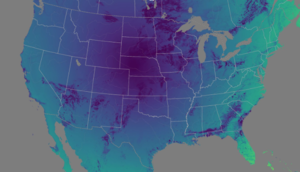2023 Forecast of Eclipse Impact on Sunlight

NOAA’s weather model predicts how the solar eclipse will influence weather
NOAA GSL scientists have included effects of solar eclipses in NOAA's High Resolution Rapid Refresh (HRRR) operational weather model, which provides critical weather forecasts for the energy and aviation industries.
When the moon’s shadow sweeps across the U.S. West from Oregon to Texas during the annular eclipse on October 14, people working in the energy industry may be able to sit back for a moment and enjoy the event with less worry than in the past. That’s because this time around, NOAA’s short-range HRRR weather forecast model includes the eclipse in its weather forecasts – and that means better forecasts for the wind, solar, and even conventional energy sectors.
“This is important for the energy industry, allowing them to use NOAA’s weather model toward predicting solar and wind power generation even during rare but important eclipse disruptions,” said Stan Benjamin, a CIRES scientist who was the senior scientist at the NOAA Global Systems Laboratory (GSL) until his federal retirement last year.
In places where rooftop solar energy, solar farms, or wind farms contribute to power generation, the industry will now be able to model potential disruptions caused by the eclipse and make plans to adjust generation and backup.
Benjamin and his team—including colleagues from NOAA GSL, CIRES, and CIRA—first incorporated eclipses into the then-experimental version of the HRRR model prior to the 2017 total solar eclipse, and it worked well, Benjamin said. By the time a partial solar eclipse hit the Arctic in June of 2021, NOAA’s operational weather forecasts included eclipses.
Figure 2: GSL-developed HRRR model shows how the 2017 eclipse impacts Incoming Solar Radiation in a 12-h model forecast starting that morning at 1200 UTC.
In a solar eclipse, the moon passes between Earth and the sun, fully or partially obscuring our star for a little while, and temperatures can dip 4-10 degrees F (2-6 C). Less solar radiation hits the Earth, and since spatial differences in solar radiation drive turbulence in the atmosphere, the winds will quiet for a while. For a few hours that morning, as the eclipse passes by and temperatures remain lower for longer, the turbulent eddies that normally mix up the lowest part of our atmosphere will be less intense, which can greatly affect changes in the lowest part of the atmosphere. Less turbulence can affect low-level clouds, too, and some may disappear before or after the eclipse, with further impacts on the amount of downwelling solar energy.
Thanks to this team’s work, the HRRR will now represent all solar eclipses that will occur in the next four decades (image below), including the total solar eclipse that will pass over the United States from Texas to the Northeast on April 8, 2024.
Figure 3: Visualization of the paths of eclipses over the next 40 years.
Energy industry representatives have publicly shared their gratitude to the team on LinkedIn. “Thanks for the amazing teamwork!” Amber Motley, director of short-term forecasting at the California Independent Systems Operator, wrote to Benjamin. “Grateful to be able to utilize the HRRR to account for impacts.”
“Improvements like this to the HRRR are an example of the research being done by NOAA and its partners,” said Dave Turner, GSL’s current senior scientist. “Scientists in NOAA are focusing on how to provide improved forecasts of solar and wind, which has been demonstrated to save the energy consumers potentially tens of millions of dollars per year by providing the information needed by the energy companies to more efficiently integrate renewable energy into the electrical grid. More accurate solar and wind forecasts from NOAA also help to accelerate the decarbonization of power generation in the United States.”
